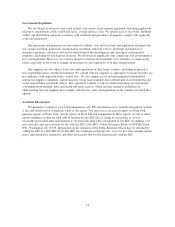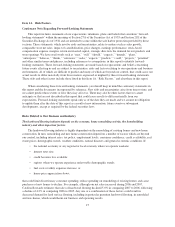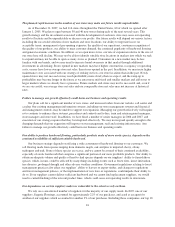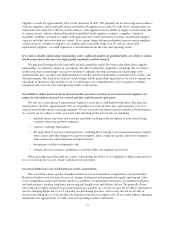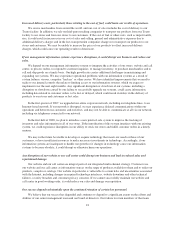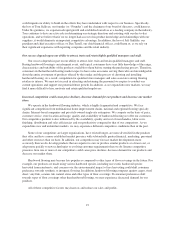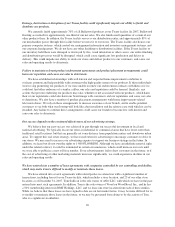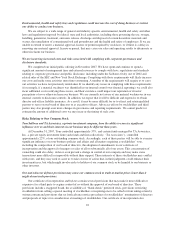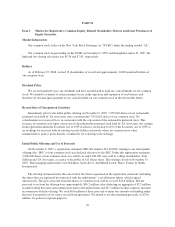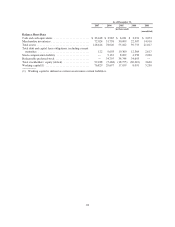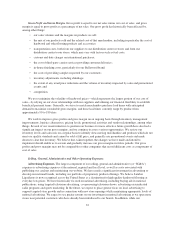Lumber Liquidators 2007 Annual Report Download - page 28
Download and view the complete annual report
Please find page 28 of the 2007 Lumber Liquidators annual report below. You can navigate through the pages in the report by either clicking on the pages listed below, or by using the keyword search tool below to find specific information within the annual report.Environmental, health and safety laws and regulations could increase the cost of doing business or restrict
our ability to conduct our business.
We are subject to a wide range of general and industry-specific environmental, health and safety and other
laws and regulations imposed by federal, state and local authorities, including those governing the use, storage,
handling, generation, treatment, emission, release, discharge and disposal of certain hazardous materials and
wastes, the remediation of contaminated soil and groundwater and the health and safety of employees. If we are
unable to extend or renew a material approval, license or permit required by such laws, or if there is a delay in
renewing any material approval, license or permit, that may cause our sales and operating results to deteriorate or
otherwise harm our business.
We are incurring increased costs and risks associated with complying with corporate governance and
disclosure standards.
We completed our initial public offering in November 2007. We have spent and continue to spend a
significant amount of management time and external resources to comply with laws, regulations and standards
relating to corporate governance and public disclosure, including under the Sarbanes-Oxley Act of 2002 and
related rules of the SEC and New York Stock Exchange. Complying with those requirements will likely increase
our costs and make some activities more time-consuming. A number of the requirements will require us to carry
out activities we have not previously undertaken. If we identify any issues in complying with those requirements
(for example, if a material weakness was identified in our internal control over financial reporting), we could also
incur additional costs rectifying those issues, and their existence could impact our reputation or investor
perceptions of us or otherwise harm our business. We are currently not aware of any material weaknesses in our
internal controls or disclosure controls. In addition, we expect that it will be difficult and expensive to obtain
director and officer liability insurance. As a result, it may be more difficult for us to attract and retain qualified
persons to serve on our board of directors or as executive officers. Advocacy efforts by stockholders and third
parties may also prompt even more changes in governance and reporting requirements. We cannot predict or
estimate the amount of additional costs we may incur or the timing of such costs.
Risks Relating to Our Common Stock
Tom Sullivan and TA Associates, a private investment company, have the ability to exercise significant
influence over us and their interests in our business may be different than yours.
At December 31, 2007, Tom controlled approximately 37%, and certain funds managed by TA Associates,
Inc., a private equity investment firm (such funds and firm collectively, “TA Associates”), controlled
approximately 22%, of our outstanding common stock. Accordingly, each of these parties will be able to exercise
significant influence over our business policies and affairs and all matters requiring a stockholders’ vote,
including the composition of our board of directors, the adoption of amendments to our certificate of
incorporation and the approval of mergers or sales of all or substantially all of our assets. This concentration of
ownership could also delay, defer or even prevent a change in control of our company and may make some
transactions more difficult or impossible without their support. These interests of these stockholders may conflict
with yours, and they may seek to cause us to take courses of action that, in their judgment, could enhance their
investment in us, but which might involve risks to holders of our common stock or be harmful to our business or
other investors.
Our anti-takeover defense provisions may cause our common stock to trade at market prices lower than it
might absent such provisions.
Our certificate of incorporation and bylaws contain several provisions that may make it more difficult or
expensive for a third party to acquire control of us without the approval of our board of directors. These
provisions include a staggered board, the availability of “blank check” preferred stock, provisions restricting
stockholders from calling a special meeting of stockholders or requiring one to be called or from taking action by
written consent and provisions that set forth advance notice procedures for stockholders’ nominations of directors
and proposals of topics for consideration at meetings of stockholders. Our certificate of incorporation also
22




